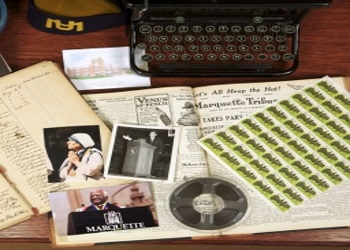LEE WHITEHORSE SUTTON COLLECTION: Scope and Content Note
Audio recordings of traditional American Indian songs in indigenous languages created for instructional purposes at the American Indian Center, Chicago, Illinois. Most songs pertain to the Comanche, Kiowa, Dakota-Lakota, and Ojibwa people of Oklahoma, North Dakota, South Dakota, and Wisconsin.
Gift of Linda Hayford, 1999. Processed by Mark G. Thiel, 2000, with biographical notes by Earl Fenner, 2002 and 2007.
Biographical Note
Henry Ray "Lee Whitehorse" Sutton (1902-ca. 1970) of Watonga, Oklahoma, was a leading Southern Arapaho singer since the 1930s. He was also involved in rodeos and his brothers were chiefs of the Cheyenne and Arapaho Indians.
Sutton married Chauncina, a daughter of Dakota silent film star Chauncy Yellowrobe of Pine Ridge, South Dakota, and granddaughter of Dakota chief Sitting Bull (Tatanka Iyotake, ca. 1831-1890). Together Lee and Chauncina were involved in Vaudeville and produced a sideshow with Chauncina performing as a snake handler and charmer and Lee selling "snake oil." They had at least three children.
Sutton was a World War II veteran, who like many other American Indians, brought his family to Chicago after the war. He became an ironworker and in 1953, he co-founded the American Indian Center where he and his family were active for many years. Sutton advocated inclusive inter-tribal powwows to build solidarity and resolve controversies over differences between tribes. He championed the concept of the powwow arena as "neutral ground" to members of all tribes who were welcome to participate and share traditions as equals without preference to any one tribe. The Suttons were close friends of Reverend Peter Powell and active in St. Augustine's Church (Episcopal). Sutton was buried in Canton, Oklahoma. Following his death, his family left the Chicago area.
Scope and Content
Series 1: The approximately 40 songs relate primarily to tribes residing today in North and South Dakota, Oklahoma, and Wisconsin. 21 are identified as Dakota (Brule, Dakota, Hunkpapa, Oglala, Sans Arc, and/or Yankton), two are identified as Ojibwa (one from Canada), and one each as Atsina (Gros Ventre), Cheyenne, Comanche, Kiowa, Menominee, Taos, and Winnebago (Ho-Chunk). Several have no identified tribal affiliation. However, the songs somewhat reflect the tribal diversity of Chicago during the mid-20th century.
Many of the tapes are studio recordings produced by Lee Whitehorse Sutton under his label, “Chunksa-Uha Sings.” The tapes were then duplicated as 78 r.p.m. record discs and distributed at the American Indian Center. The recordings introduce each song with separate demonstrations of song phrases with explanations in English on song performance and related dances along with translations, interpretations, and histories of the song texts. The titles of songs and other recordings are derived from the original box labels with the recording numbers, if any, included in brackets. Recording 111 Grass ("Pezhi") Dance Song/Sioux (Dakota) Contest Song was missing from the collection when donated to Marquette and duplicate copies of 101 and 104 were included.
Wav files are available for the series 1 recordings, which were reformatted in 2016.
Series 2: Recordings of project discussions; not reformatted.
Series 3: Recordings of Chicago area Native American celebrations; not reformatted.
Series 0: Unprocessed recordings; not reformatted.
More Related Resources
- Catholic Native America Collections: Checklist to Marquette special collections about native peoples.
- Search the Collections (sidebar)






